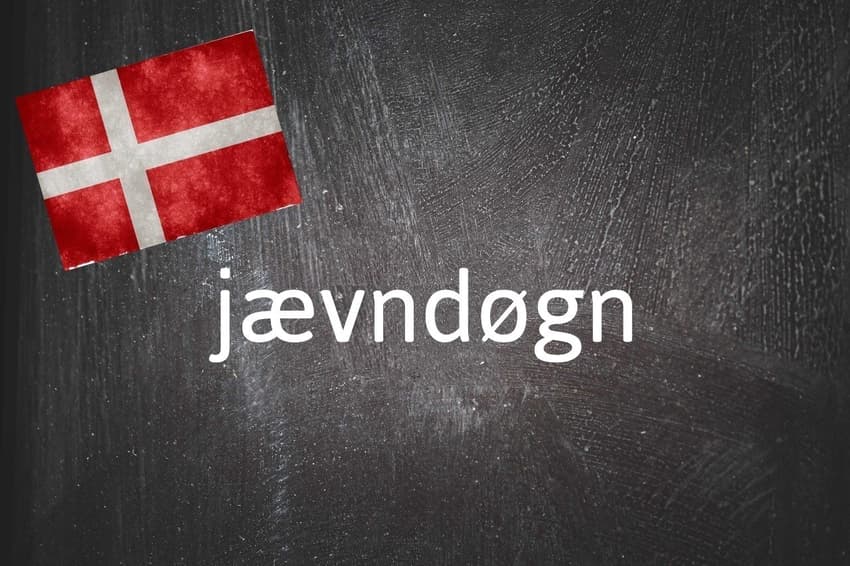Danish word of the day: Jævndøgn

Photo by Francesco Ungaro on Unsplash and Nicolas Raymond/FlickR
The light and the dark side are now in balance.
What is jævndøgn?
Jævndøgn the term used to describe the spring (forårsjævndøgn) and autumn (efterårsjævndøgn) equinoxes.
On the day of an equinox, daytime and nighttime are of approximately equal duration (this is true at the same time all over the planet, not just in Denmark).
The word used in English, equinox, comes from Latin: aequus (equal) and nox (night). The Danish term is directly related to Old English and Norse. Jævn is an adjective similar to “even” and can be used to describe a physical quality (en jævn overflade is “an even surface”), as well as to mean “equal”.
While jævn is “equal” when talking about the equinox and in various other formulations related to measurement, a different word, lighed or ligestilling, is used to mean “equality”.
Døgn is a useful Danish word that doesn’t have an exact English translation but can both mean “a day” or “a 24-hour period”. It’s usually used in preference to the more common dag (“day”) when talking about the amount of time within a day, and not to the day in general.
For example, a store that is open 24 hours a day is described as døgnåbent, “24-hour-open”. If you arbejder døgnet rundt you work all hours of the day.
Putting jævn and døgn together gives you the Danish word for equinox, jævndøgn, literally “equal 24-hours”.
Why do I need to know jævndøgn?
In 2024, March 20th is the spring equinox or forårsjævndøgn (in some years the equinox falls on the 21st), after which the days will include more light minutes than dark ones. The autumn equinox or efterårsjævndøgn falls on September 24th, -- when the days will go back to being shorter than the nights.
The summer solstice, the date with the most daylight hours was on June 20th. In Denmark, that means over 17 hours of daylight. The Danish word for solstice is solhverv, from sol (sun) and hverv, an archaic word for “turning”.
The longest night of the year usually falls on December 21st, the winter solstice, when Denmark can expect 17 hours of darkness.
Pronunciation
The “j” in jævn is pronounced like the “y” in “yellow and the “v” as a “w”, giving you “yæwn”.
To say døgn, imagine you are saying “boy” but replacing the b with a d. Then add an “n” at the end.
Example
I dag er det jævndøgn, hvor dag og nat er lige lange.
Today is the equinox, when day and night are the same length.
Comments
See Also
What is jævndøgn?
Jævndøgn the term used to describe the spring (forårsjævndøgn) and autumn (efterårsjævndøgn) equinoxes.
On the day of an equinox, daytime and nighttime are of approximately equal duration (this is true at the same time all over the planet, not just in Denmark).
The word used in English, equinox, comes from Latin: aequus (equal) and nox (night). The Danish term is directly related to Old English and Norse. Jævn is an adjective similar to “even” and can be used to describe a physical quality (en jævn overflade is “an even surface”), as well as to mean “equal”.
While jævn is “equal” when talking about the equinox and in various other formulations related to measurement, a different word, lighed or ligestilling, is used to mean “equality”.
Døgn is a useful Danish word that doesn’t have an exact English translation but can both mean “a day” or “a 24-hour period”. It’s usually used in preference to the more common dag (“day”) when talking about the amount of time within a day, and not to the day in general.
For example, a store that is open 24 hours a day is described as døgnåbent, “24-hour-open”. If you arbejder døgnet rundt you work all hours of the day.
Putting jævn and døgn together gives you the Danish word for equinox, jævndøgn, literally “equal 24-hours”.
Why do I need to know jævndøgn?
In 2024, March 20th is the spring equinox or forårsjævndøgn (in some years the equinox falls on the 21st), after which the days will include more light minutes than dark ones. The autumn equinox or efterårsjævndøgn falls on September 24th, -- when the days will go back to being shorter than the nights.
The summer solstice, the date with the most daylight hours was on June 20th. In Denmark, that means over 17 hours of daylight. The Danish word for solstice is solhverv, from sol (sun) and hverv, an archaic word for “turning”.
The longest night of the year usually falls on December 21st, the winter solstice, when Denmark can expect 17 hours of darkness.
Pronunciation
The “j” in jævn is pronounced like the “y” in “yellow and the “v” as a “w”, giving you “yæwn”.
To say døgn, imagine you are saying “boy” but replacing the b with a d. Then add an “n” at the end.
Example
I dag er det jævndøgn, hvor dag og nat er lige lange.
Today is the equinox, when day and night are the same length.
Join the conversation in our comments section below. Share your own views and experience and if you have a question or suggestion for our journalists then email us at [email protected].
Please keep comments civil, constructive and on topic – and make sure to read our terms of use before getting involved.
Please log in here to leave a comment.